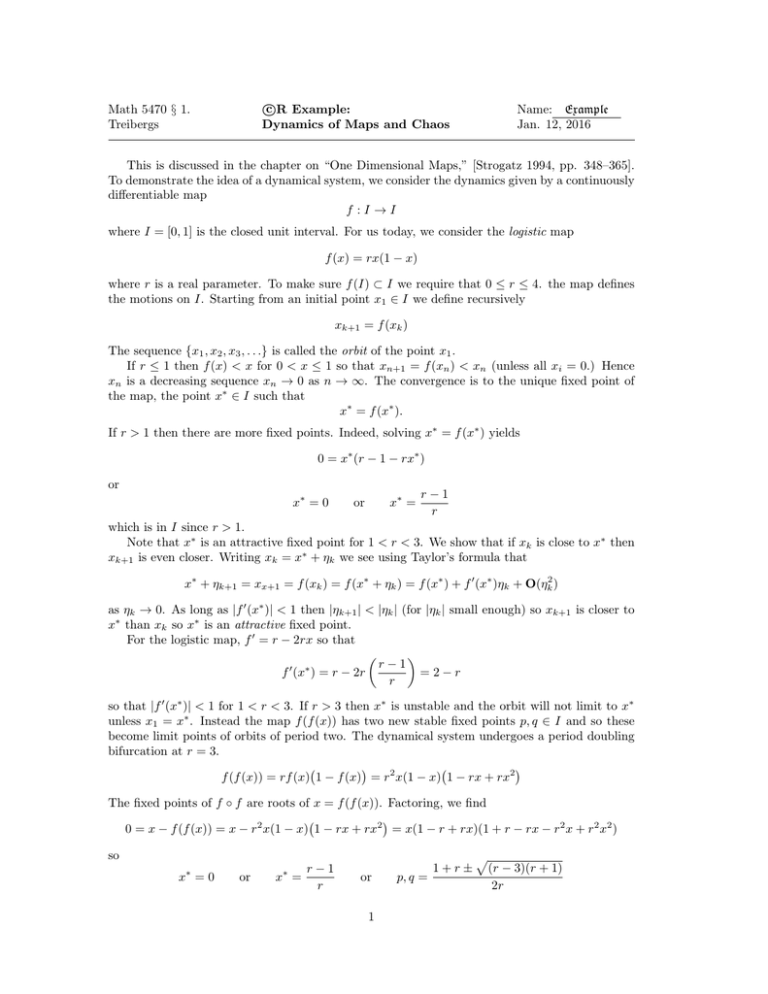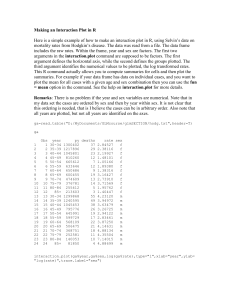Document 11281381
advertisement

Math 5470 § 1.
Treibergs
c
R
Example:
Dynamics of Maps and Chaos
Name: Example
Jan. 12, 2016
This is discussed in the chapter on “One Dimensional Maps,” [Strogatz 1994, pp. 348–365].
To demonstrate the idea of a dynamical system, we consider the dynamics given by a continuously
differentiable map
f :I→I
where I = [0, 1] is the closed unit interval. For us today, we consider the logistic map
f (x) = rx(1 − x)
where r is a real parameter. To make sure f (I) ⊂ I we require that 0 ≤ r ≤ 4. the map defines
the motions on I. Starting from an initial point x1 ∈ I we define recursively
xk+1 = f (xk )
The sequence {x1 , x2 , x3 , . . .} is called the orbit of the point x1 .
If r ≤ 1 then f (x) < x for 0 < x ≤ 1 so that xn+1 = f (xn ) < xn (unless all xi = 0.) Hence
xn is a decreasing sequence xn → 0 as n → ∞. The convergence is to the unique fixed point of
the map, the point x∗ ∈ I such that
x∗ = f (x∗ ).
If r > 1 then there are more fixed points. Indeed, solving x∗ = f (x∗ ) yields
0 = x∗ (r − 1 − rx∗ )
or
x∗ = 0
x∗ =
or
r−1
r
which is in I since r > 1.
Note that x∗ is an attractive fixed point for 1 < r < 3. We show that if xk is close to x∗ then
xk+1 is even closer. Writing xk = x∗ + ηk we see using Taylor’s formula that
x∗ + ηk+1 = xx+1 = f (xk ) = f (x∗ + ηk ) = f (x∗ ) + f 0 (x∗ )ηk + O(ηk2 )
as ηk → 0. As long as |f 0 (x∗ )| < 1 then |ηk+1 | < |ηk | (for |ηk | small enough) so xk+1 is closer to
x∗ than xk so x∗ is an attractive fixed point.
For the logistic map, f 0 = r − 2rx so that
r−1
=2−r
f 0 (x∗ ) = r − 2r
r
so that |f 0 (x∗ )| < 1 for 1 < r < 3. If r > 3 then x∗ is unstable and the orbit will not limit to x∗
unless x1 = x∗ . Instead the map f (f (x)) has two new stable fixed points p, q ∈ I and so these
become limit points of orbits of period two. The dynamical system undergoes a period doubling
bifurcation at r = 3.
f (f (x)) = rf (x) 1 − f (x) = r2 x(1 − x) 1 − rx + rx2
The fixed points of f ◦ f are roots of x = f (f (x)). Factoring, we find
0 = x − f (f (x)) = x − r2 x(1 − x) 1 − rx + rx2 = x(1 − r + rx)(1 + r − rx − r2 x + r2 x2 )
so
∗
x =0
or
r−1
x =
r
∗
or
1
p, q =
1+r±
p
(r − 3)(r + 1)
2r
c
This example is done in R.
First we plot y = x, y = f (x) for r = 2.9 and y = x, y = f (f (x))
for r = 3.2.
Second we compute the sequence xn for the staring values x1 = 1/π and for various r. The
zig-zag line from (1, x1 ) to (2, x2 ) to (3, x3 ) and so on shows the dynamics. We consider several
cases: when there is an attractive fixed point, after the first few period doubling bifurcations, and
in the chaos region r > r∞ = 3.569946 . . . For r = 3.83, the orbit has period three. For r = 3.828
near there, there is intermittent behavior: the orbit has period three or so for a long time and
then there is a spurt of chaotic activity until it settles down again.
R Session:
R version 3.2.1 (2015-06-18) -- "World-Famous Astronaut"
Copyright (C) 2015 The R Foundation for Statistical Computing
Platform: x86_64-apple-darwin14.5.0 (64-bit)
R is free software and comes with ABSOLUTELY NO WARRANTY.
You are welcome to redistribute it under certain conditions.
Type ’license()’ or ’licence()’ for distribution details.
Natural language support but running in an English locale
R is a collaborative project with many contributors.
Type ’contributors()’ for more information and
’citation()’ on how to cite R or R packages in publications.
Type ’demo()’ for some demos, ’help()’ for on-line help, or
’help.start()’ for an HTML browser interface to help.
Type ’q()’ to quit R.
[Workspace loaded from /home/1004/ma/treibergs/.RData]
> # Plot y=f(x)
> x=0:299/299
> r=2.9; f = function(x){r*x*(1-x)}
> plot(x,f(x),ylim=0:1,type="l"); abline(0,1,lty=4)
>
># Plot y=f(f(x))
> r=3.2; f = function(x){r*x*(1-x)}
> plot(x,f(f(x)),ylim=0:1,type="l"); abline(0,1,lty=4)
>
> # Iterate the map. print the first 21 c[n]’s
> r=2.9; c[1]=1/pi; for(k in 1:20){c[k+1]=r*c[k]*(1-c[k])};c;
[1] 0.3183099 0.6292672 0.6765409 0.6346166 0.6724473 0.6387596 0.6691628 0.6420135
[9] 0.6665133 0.6445926 0.6643696 0.6466496 0.6626323 0.6482972 0.6612231 0.6496207
[17] 0.6600796 0.6506861 0.6591517 0.6515451 0.6583988
2
# Iterate with different
r
values. Plot points
(n,c[n])
connected by lines.
r=2.9; c[1]=1/pi; for(k in 1:99){c[k+1]=r*c[k]*(1-c[k])};plot(c,type="l",xlab="r = 2.9")
r=3.2; c[1]=1/pi; for(k in 1:99){c[k+1]=r*c[k]*(1-c[k])};plot(c,type="l",xlab="r = 3.2")
r=3.5; c[1]=1/pi; for(k in 1:99){c[k+1]=r*c[k]*(1-c[k])};plot(c,type="l",xlab="r = 3.5")
r=3.55; c[1]=1/pi; for(k in 1:99){c[k+1]=r*c[k]*(1-c[k])};plot(c,type="l",xlab="r=3.55")
r=3.83; c[1]=1/pi; for(k in 1:99){c[k+1]=r*c[k]*(1-c[k])};plot(c,type="l",xlab="r=3.83")
r=3.828; c[1]=1/pi; for(k in 1:99){c[k+1]=r*c[k]*(1-c[k])};plot(c,type="l",xlab="r = 3.828")
0.0
0.2
0.4
f(x)
0.6
0.8
1.0
>
>
>
>
>
>
>
>
>
>
>
>
0.0
0.2
0.4
0.6
x
3
0.8
1.0
0.0
0.2
0.4
4
0.6
x
0.8
1.0
0.0
0.2
0.4
0.6
f(f(x))
0.8
1.0
0.65
0.55
0.35
0.45
c
0
20
40
60
r = 2.9
5
80
100
0.8
0.7
0.6
0.3
0.4
0.5
c
0
20
40
60
r = 3.2
6
80
100
0.8
0.7
c
0.6
0.5
0.4
0.3
0
20
40
60
r = 3.5
7
80
100
0
20
40
60
r=3.55
8
80
100
0.3
0.4
0.5
0.6
c
0.7
0.8
0.9
0.8
0.6
0.2
0.4
c
0
20
40
60
r=3.83
9
80
100
0.8
0.6
0.2
0.4
c
0
20
40
60
r = 3.828
10
80
100



